Health Disparities Among New Zealand Subgroups and Waitangi Convention
VerifiedAdded on 2020/03/23
|20
|5978
|77
Essay
AI Summary
This essay delves into the critical issue of health disparities among various subgroups in New Zealand, examining the significant gaps in health outcomes and access to healthcare services. It highlights socioeconomic factors such as income, employment, and literacy levels, as well as cultural beliefs and practices, as key determinants of these inequalities. The essay analyzes how these factors influence health outcomes, particularly for Maori and Pacific populations, and discusses the role of the Waitangi Convention in addressing health disparities and promoting equitable healthcare access. The discussion includes the Maori health model (Haori) that provides a culturally appropriate health care to the Maori and non-Maori communities. The essay emphasizes the need for resource distribution, and culturally sensitive healthcare approaches to reduce health inequalities and improve overall well-being within New Zealand.
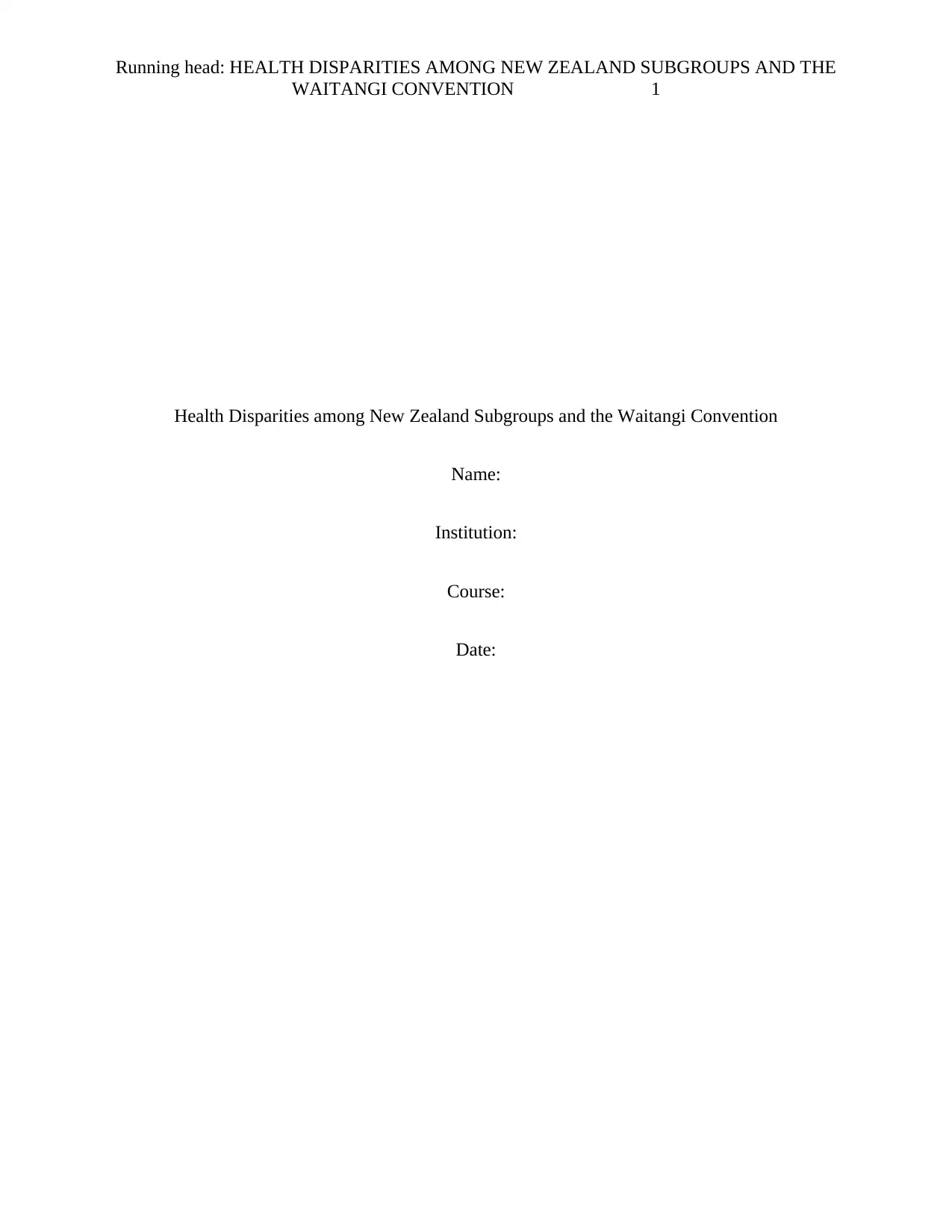
Running head: HEALTH DISPARITIES AMONG NEW ZEALAND SUBGROUPS AND THE
WAITANGI CONVENTION 1
Health Disparities among New Zealand Subgroups and the Waitangi Convention
Name:
Institution:
Course:
Date:
WAITANGI CONVENTION 1
Health Disparities among New Zealand Subgroups and the Waitangi Convention
Name:
Institution:
Course:
Date:
Paraphrase This Document
Need a fresh take? Get an instant paraphrase of this document with our AI Paraphraser
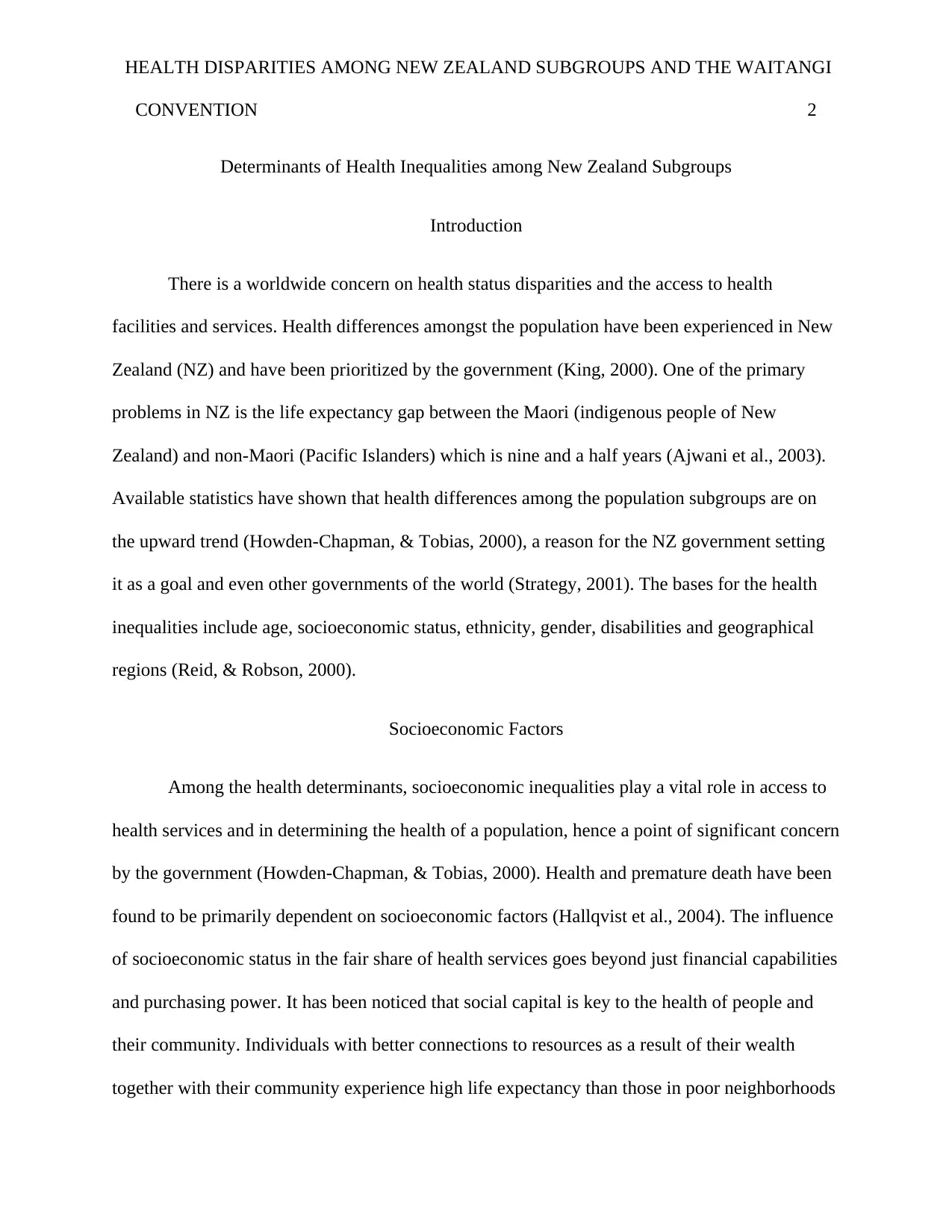
HEALTH DISPARITIES AMONG NEW ZEALAND SUBGROUPS AND THE WAITANGI
CONVENTION 2
Determinants of Health Inequalities among New Zealand Subgroups
Introduction
There is a worldwide concern on health status disparities and the access to health
facilities and services. Health differences amongst the population have been experienced in New
Zealand (NZ) and have been prioritized by the government (King, 2000). One of the primary
problems in NZ is the life expectancy gap between the Maori (indigenous people of New
Zealand) and non-Maori (Pacific Islanders) which is nine and a half years (Ajwani et al., 2003).
Available statistics have shown that health differences among the population subgroups are on
the upward trend (Howden-Chapman, & Tobias, 2000), a reason for the NZ government setting
it as a goal and even other governments of the world (Strategy, 2001). The bases for the health
inequalities include age, socioeconomic status, ethnicity, gender, disabilities and geographical
regions (Reid, & Robson, 2000).
Socioeconomic Factors
Among the health determinants, socioeconomic inequalities play a vital role in access to
health services and in determining the health of a population, hence a point of significant concern
by the government (Howden-Chapman, & Tobias, 2000). Health and premature death have been
found to be primarily dependent on socioeconomic factors (Hallqvist et al., 2004). The influence
of socioeconomic status in the fair share of health services goes beyond just financial capabilities
and purchasing power. It has been noticed that social capital is key to the health of people and
their community. Individuals with better connections to resources as a result of their wealth
together with their community experience high life expectancy than those in poor neighborhoods
CONVENTION 2
Determinants of Health Inequalities among New Zealand Subgroups
Introduction
There is a worldwide concern on health status disparities and the access to health
facilities and services. Health differences amongst the population have been experienced in New
Zealand (NZ) and have been prioritized by the government (King, 2000). One of the primary
problems in NZ is the life expectancy gap between the Maori (indigenous people of New
Zealand) and non-Maori (Pacific Islanders) which is nine and a half years (Ajwani et al., 2003).
Available statistics have shown that health differences among the population subgroups are on
the upward trend (Howden-Chapman, & Tobias, 2000), a reason for the NZ government setting
it as a goal and even other governments of the world (Strategy, 2001). The bases for the health
inequalities include age, socioeconomic status, ethnicity, gender, disabilities and geographical
regions (Reid, & Robson, 2000).
Socioeconomic Factors
Among the health determinants, socioeconomic inequalities play a vital role in access to
health services and in determining the health of a population, hence a point of significant concern
by the government (Howden-Chapman, & Tobias, 2000). Health and premature death have been
found to be primarily dependent on socioeconomic factors (Hallqvist et al., 2004). The influence
of socioeconomic status in the fair share of health services goes beyond just financial capabilities
and purchasing power. It has been noticed that social capital is key to the health of people and
their community. Individuals with better connections to resources as a result of their wealth
together with their community experience high life expectancy than those in poor neighborhoods
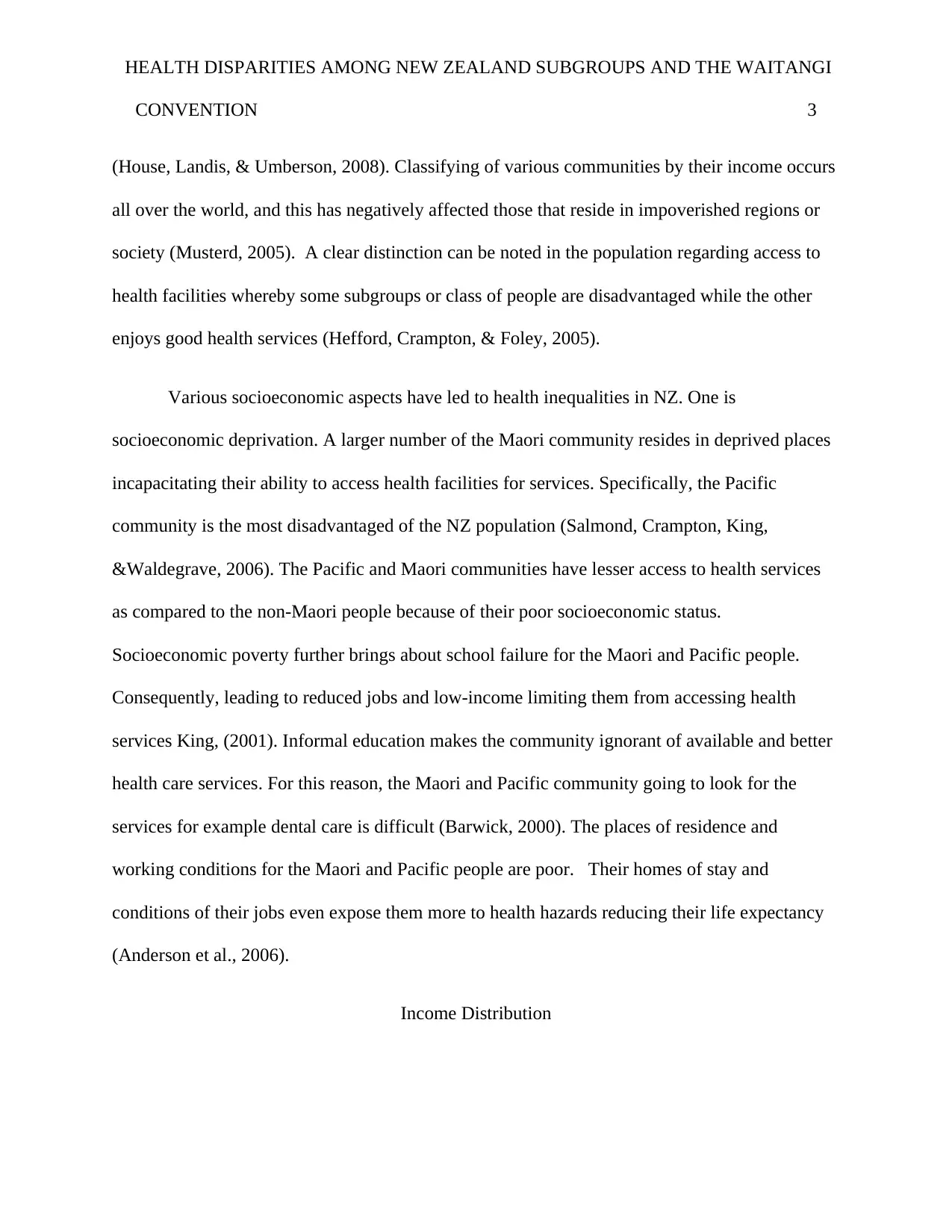
HEALTH DISPARITIES AMONG NEW ZEALAND SUBGROUPS AND THE WAITANGI
CONVENTION 3
(House, Landis, & Umberson, 2008). Classifying of various communities by their income occurs
all over the world, and this has negatively affected those that reside in impoverished regions or
society (Musterd, 2005). A clear distinction can be noted in the population regarding access to
health facilities whereby some subgroups or class of people are disadvantaged while the other
enjoys good health services (Hefford, Crampton, & Foley, 2005).
Various socioeconomic aspects have led to health inequalities in NZ. One is
socioeconomic deprivation. A larger number of the Maori community resides in deprived places
incapacitating their ability to access health facilities for services. Specifically, the Pacific
community is the most disadvantaged of the NZ population (Salmond, Crampton, King,
&Waldegrave, 2006). The Pacific and Maori communities have lesser access to health services
as compared to the non-Maori people because of their poor socioeconomic status.
Socioeconomic poverty further brings about school failure for the Maori and Pacific people.
Consequently, leading to reduced jobs and low-income limiting them from accessing health
services King, (2001). Informal education makes the community ignorant of available and better
health care services. For this reason, the Maori and Pacific community going to look for the
services for example dental care is difficult (Barwick, 2000). The places of residence and
working conditions for the Maori and Pacific people are poor. Their homes of stay and
conditions of their jobs even expose them more to health hazards reducing their life expectancy
(Anderson et al., 2006).
Income Distribution
CONVENTION 3
(House, Landis, & Umberson, 2008). Classifying of various communities by their income occurs
all over the world, and this has negatively affected those that reside in impoverished regions or
society (Musterd, 2005). A clear distinction can be noted in the population regarding access to
health facilities whereby some subgroups or class of people are disadvantaged while the other
enjoys good health services (Hefford, Crampton, & Foley, 2005).
Various socioeconomic aspects have led to health inequalities in NZ. One is
socioeconomic deprivation. A larger number of the Maori community resides in deprived places
incapacitating their ability to access health facilities for services. Specifically, the Pacific
community is the most disadvantaged of the NZ population (Salmond, Crampton, King,
&Waldegrave, 2006). The Pacific and Maori communities have lesser access to health services
as compared to the non-Maori people because of their poor socioeconomic status.
Socioeconomic poverty further brings about school failure for the Maori and Pacific people.
Consequently, leading to reduced jobs and low-income limiting them from accessing health
services King, (2001). Informal education makes the community ignorant of available and better
health care services. For this reason, the Maori and Pacific community going to look for the
services for example dental care is difficult (Barwick, 2000). The places of residence and
working conditions for the Maori and Pacific people are poor. Their homes of stay and
conditions of their jobs even expose them more to health hazards reducing their life expectancy
(Anderson et al., 2006).
Income Distribution
⊘ This is a preview!⊘
Do you want full access?
Subscribe today to unlock all pages.

Trusted by 1+ million students worldwide
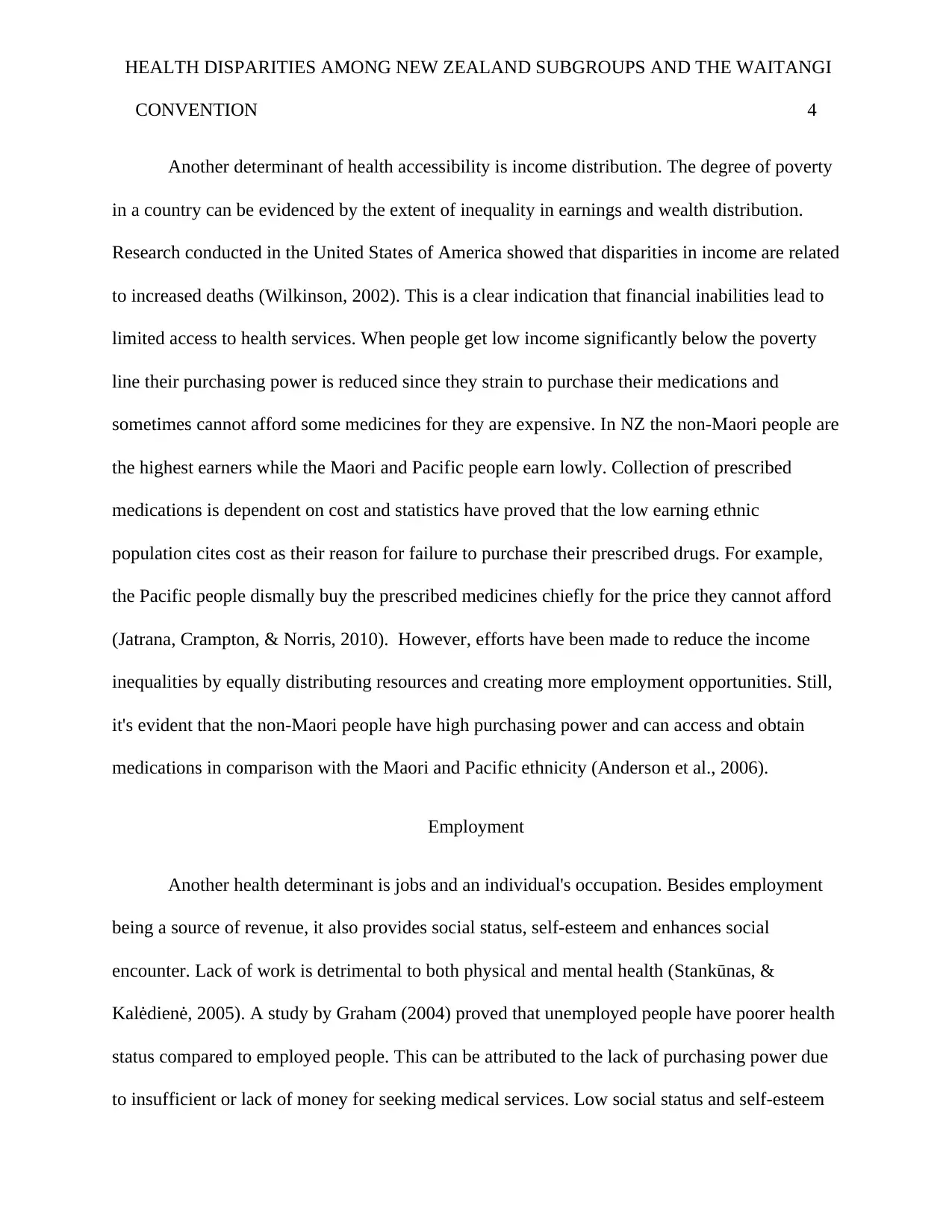
HEALTH DISPARITIES AMONG NEW ZEALAND SUBGROUPS AND THE WAITANGI
CONVENTION 4
Another determinant of health accessibility is income distribution. The degree of poverty
in a country can be evidenced by the extent of inequality in earnings and wealth distribution.
Research conducted in the United States of America showed that disparities in income are related
to increased deaths (Wilkinson, 2002). This is a clear indication that financial inabilities lead to
limited access to health services. When people get low income significantly below the poverty
line their purchasing power is reduced since they strain to purchase their medications and
sometimes cannot afford some medicines for they are expensive. In NZ the non-Maori people are
the highest earners while the Maori and Pacific people earn lowly. Collection of prescribed
medications is dependent on cost and statistics have proved that the low earning ethnic
population cites cost as their reason for failure to purchase their prescribed drugs. For example,
the Pacific people dismally buy the prescribed medicines chiefly for the price they cannot afford
(Jatrana, Crampton, & Norris, 2010). However, efforts have been made to reduce the income
inequalities by equally distributing resources and creating more employment opportunities. Still,
it's evident that the non-Maori people have high purchasing power and can access and obtain
medications in comparison with the Maori and Pacific ethnicity (Anderson et al., 2006).
Employment
Another health determinant is jobs and an individual's occupation. Besides employment
being a source of revenue, it also provides social status, self-esteem and enhances social
encounter. Lack of work is detrimental to both physical and mental health (Stankūnas, &
Kalėdienė, 2005). A study by Graham (2004) proved that unemployed people have poorer health
status compared to employed people. This can be attributed to the lack of purchasing power due
to insufficient or lack of money for seeking medical services. Low social status and self-esteem
CONVENTION 4
Another determinant of health accessibility is income distribution. The degree of poverty
in a country can be evidenced by the extent of inequality in earnings and wealth distribution.
Research conducted in the United States of America showed that disparities in income are related
to increased deaths (Wilkinson, 2002). This is a clear indication that financial inabilities lead to
limited access to health services. When people get low income significantly below the poverty
line their purchasing power is reduced since they strain to purchase their medications and
sometimes cannot afford some medicines for they are expensive. In NZ the non-Maori people are
the highest earners while the Maori and Pacific people earn lowly. Collection of prescribed
medications is dependent on cost and statistics have proved that the low earning ethnic
population cites cost as their reason for failure to purchase their prescribed drugs. For example,
the Pacific people dismally buy the prescribed medicines chiefly for the price they cannot afford
(Jatrana, Crampton, & Norris, 2010). However, efforts have been made to reduce the income
inequalities by equally distributing resources and creating more employment opportunities. Still,
it's evident that the non-Maori people have high purchasing power and can access and obtain
medications in comparison with the Maori and Pacific ethnicity (Anderson et al., 2006).
Employment
Another health determinant is jobs and an individual's occupation. Besides employment
being a source of revenue, it also provides social status, self-esteem and enhances social
encounter. Lack of work is detrimental to both physical and mental health (Stankūnas, &
Kalėdienė, 2005). A study by Graham (2004) proved that unemployed people have poorer health
status compared to employed people. This can be attributed to the lack of purchasing power due
to insufficient or lack of money for seeking medical services. Low social status and self-esteem
Paraphrase This Document
Need a fresh take? Get an instant paraphrase of this document with our AI Paraphraser
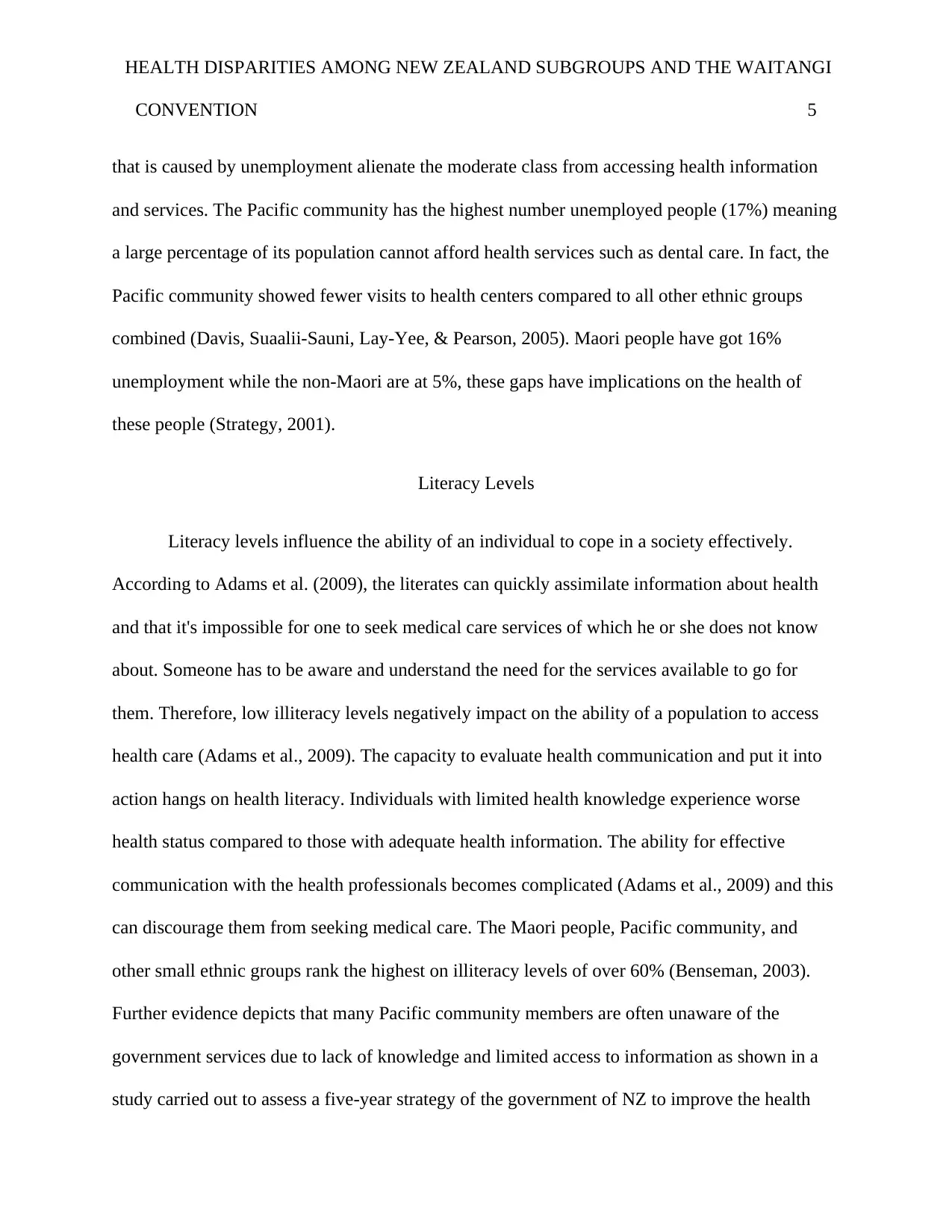
HEALTH DISPARITIES AMONG NEW ZEALAND SUBGROUPS AND THE WAITANGI
CONVENTION 5
that is caused by unemployment alienate the moderate class from accessing health information
and services. The Pacific community has the highest number unemployed people (17%) meaning
a large percentage of its population cannot afford health services such as dental care. In fact, the
Pacific community showed fewer visits to health centers compared to all other ethnic groups
combined (Davis, Suaalii-Sauni, Lay-Yee, & Pearson, 2005). Maori people have got 16%
unemployment while the non-Maori are at 5%, these gaps have implications on the health of
these people (Strategy, 2001).
Literacy Levels
Literacy levels influence the ability of an individual to cope in a society effectively.
According to Adams et al. (2009), the literates can quickly assimilate information about health
and that it's impossible for one to seek medical care services of which he or she does not know
about. Someone has to be aware and understand the need for the services available to go for
them. Therefore, low illiteracy levels negatively impact on the ability of a population to access
health care (Adams et al., 2009). The capacity to evaluate health communication and put it into
action hangs on health literacy. Individuals with limited health knowledge experience worse
health status compared to those with adequate health information. The ability for effective
communication with the health professionals becomes complicated (Adams et al., 2009) and this
can discourage them from seeking medical care. The Maori people, Pacific community, and
other small ethnic groups rank the highest on illiteracy levels of over 60% (Benseman, 2003).
Further evidence depicts that many Pacific community members are often unaware of the
government services due to lack of knowledge and limited access to information as shown in a
study carried out to assess a five-year strategy of the government of NZ to improve the health
CONVENTION 5
that is caused by unemployment alienate the moderate class from accessing health information
and services. The Pacific community has the highest number unemployed people (17%) meaning
a large percentage of its population cannot afford health services such as dental care. In fact, the
Pacific community showed fewer visits to health centers compared to all other ethnic groups
combined (Davis, Suaalii-Sauni, Lay-Yee, & Pearson, 2005). Maori people have got 16%
unemployment while the non-Maori are at 5%, these gaps have implications on the health of
these people (Strategy, 2001).
Literacy Levels
Literacy levels influence the ability of an individual to cope in a society effectively.
According to Adams et al. (2009), the literates can quickly assimilate information about health
and that it's impossible for one to seek medical care services of which he or she does not know
about. Someone has to be aware and understand the need for the services available to go for
them. Therefore, low illiteracy levels negatively impact on the ability of a population to access
health care (Adams et al., 2009). The capacity to evaluate health communication and put it into
action hangs on health literacy. Individuals with limited health knowledge experience worse
health status compared to those with adequate health information. The ability for effective
communication with the health professionals becomes complicated (Adams et al., 2009) and this
can discourage them from seeking medical care. The Maori people, Pacific community, and
other small ethnic groups rank the highest on illiteracy levels of over 60% (Benseman, 2003).
Further evidence depicts that many Pacific community members are often unaware of the
government services due to lack of knowledge and limited access to information as shown in a
study carried out to assess a five-year strategy of the government of NZ to improve the health
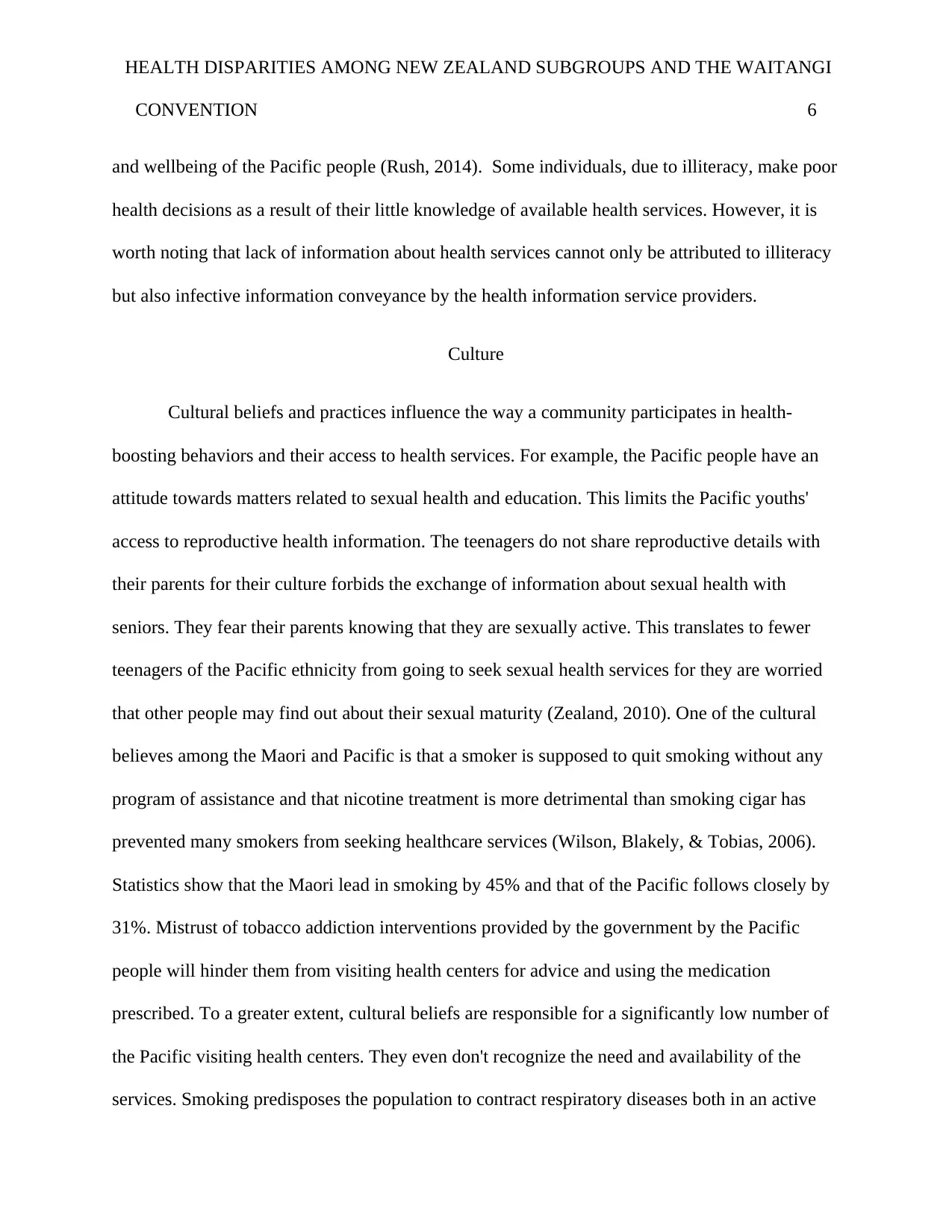
HEALTH DISPARITIES AMONG NEW ZEALAND SUBGROUPS AND THE WAITANGI
CONVENTION 6
and wellbeing of the Pacific people (Rush, 2014). Some individuals, due to illiteracy, make poor
health decisions as a result of their little knowledge of available health services. However, it is
worth noting that lack of information about health services cannot only be attributed to illiteracy
but also infective information conveyance by the health information service providers.
Culture
Cultural beliefs and practices influence the way a community participates in health-
boosting behaviors and their access to health services. For example, the Pacific people have an
attitude towards matters related to sexual health and education. This limits the Pacific youths'
access to reproductive health information. The teenagers do not share reproductive details with
their parents for their culture forbids the exchange of information about sexual health with
seniors. They fear their parents knowing that they are sexually active. This translates to fewer
teenagers of the Pacific ethnicity from going to seek sexual health services for they are worried
that other people may find out about their sexual maturity (Zealand, 2010). One of the cultural
believes among the Maori and Pacific is that a smoker is supposed to quit smoking without any
program of assistance and that nicotine treatment is more detrimental than smoking cigar has
prevented many smokers from seeking healthcare services (Wilson, Blakely, & Tobias, 2006).
Statistics show that the Maori lead in smoking by 45% and that of the Pacific follows closely by
31%. Mistrust of tobacco addiction interventions provided by the government by the Pacific
people will hinder them from visiting health centers for advice and using the medication
prescribed. To a greater extent, cultural beliefs are responsible for a significantly low number of
the Pacific visiting health centers. They even don't recognize the need and availability of the
services. Smoking predisposes the population to contract respiratory diseases both in an active
CONVENTION 6
and wellbeing of the Pacific people (Rush, 2014). Some individuals, due to illiteracy, make poor
health decisions as a result of their little knowledge of available health services. However, it is
worth noting that lack of information about health services cannot only be attributed to illiteracy
but also infective information conveyance by the health information service providers.
Culture
Cultural beliefs and practices influence the way a community participates in health-
boosting behaviors and their access to health services. For example, the Pacific people have an
attitude towards matters related to sexual health and education. This limits the Pacific youths'
access to reproductive health information. The teenagers do not share reproductive details with
their parents for their culture forbids the exchange of information about sexual health with
seniors. They fear their parents knowing that they are sexually active. This translates to fewer
teenagers of the Pacific ethnicity from going to seek sexual health services for they are worried
that other people may find out about their sexual maturity (Zealand, 2010). One of the cultural
believes among the Maori and Pacific is that a smoker is supposed to quit smoking without any
program of assistance and that nicotine treatment is more detrimental than smoking cigar has
prevented many smokers from seeking healthcare services (Wilson, Blakely, & Tobias, 2006).
Statistics show that the Maori lead in smoking by 45% and that of the Pacific follows closely by
31%. Mistrust of tobacco addiction interventions provided by the government by the Pacific
people will hinder them from visiting health centers for advice and using the medication
prescribed. To a greater extent, cultural beliefs are responsible for a significantly low number of
the Pacific visiting health centers. They even don't recognize the need and availability of the
services. Smoking predisposes the population to contract respiratory diseases both in an active
⊘ This is a preview!⊘
Do you want full access?
Subscribe today to unlock all pages.

Trusted by 1+ million students worldwide
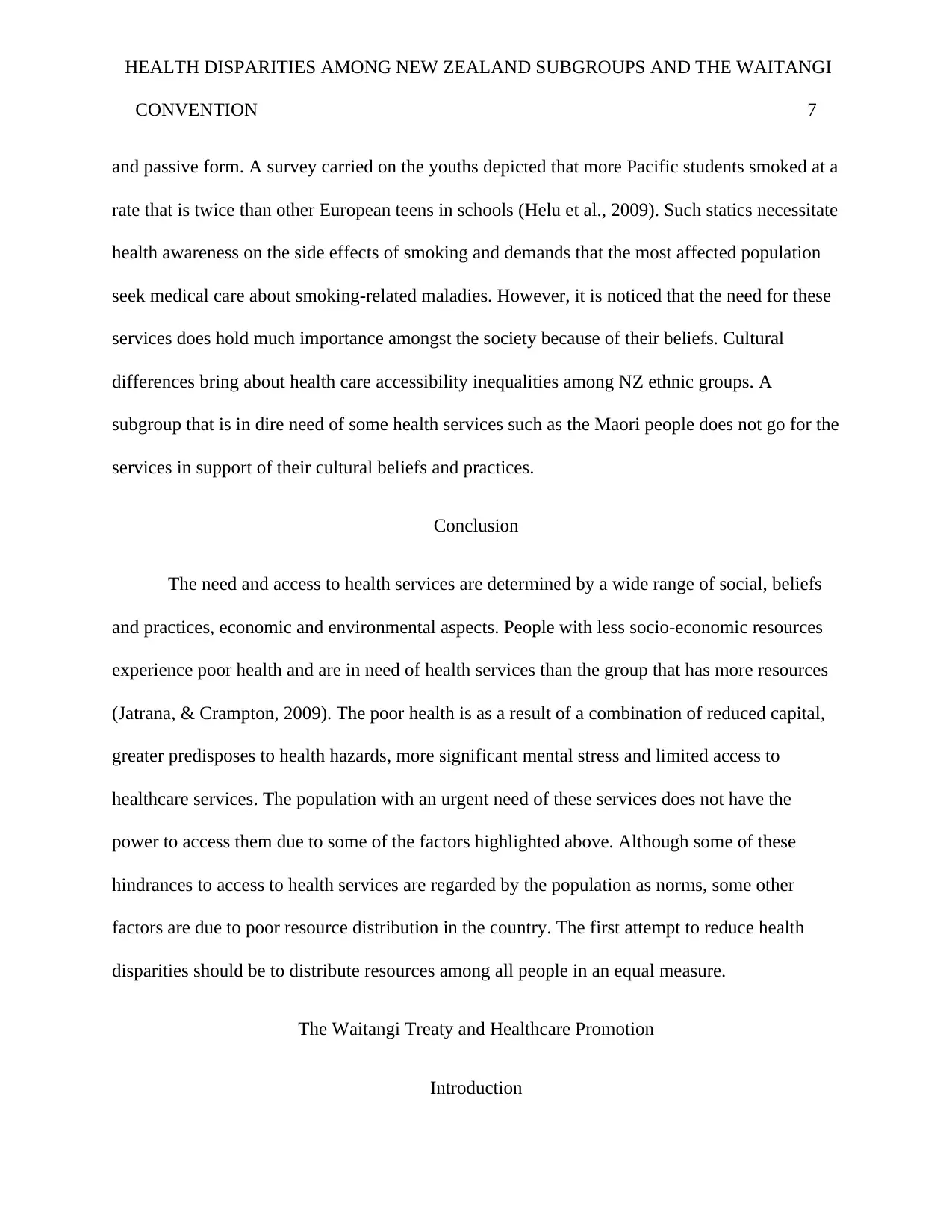
HEALTH DISPARITIES AMONG NEW ZEALAND SUBGROUPS AND THE WAITANGI
CONVENTION 7
and passive form. A survey carried on the youths depicted that more Pacific students smoked at a
rate that is twice than other European teens in schools (Helu et al., 2009). Such statics necessitate
health awareness on the side effects of smoking and demands that the most affected population
seek medical care about smoking-related maladies. However, it is noticed that the need for these
services does hold much importance amongst the society because of their beliefs. Cultural
differences bring about health care accessibility inequalities among NZ ethnic groups. A
subgroup that is in dire need of some health services such as the Maori people does not go for the
services in support of their cultural beliefs and practices.
Conclusion
The need and access to health services are determined by a wide range of social, beliefs
and practices, economic and environmental aspects. People with less socio-economic resources
experience poor health and are in need of health services than the group that has more resources
(Jatrana, & Crampton, 2009). The poor health is as a result of a combination of reduced capital,
greater predisposes to health hazards, more significant mental stress and limited access to
healthcare services. The population with an urgent need of these services does not have the
power to access them due to some of the factors highlighted above. Although some of these
hindrances to access to health services are regarded by the population as norms, some other
factors are due to poor resource distribution in the country. The first attempt to reduce health
disparities should be to distribute resources among all people in an equal measure.
The Waitangi Treaty and Healthcare Promotion
Introduction
CONVENTION 7
and passive form. A survey carried on the youths depicted that more Pacific students smoked at a
rate that is twice than other European teens in schools (Helu et al., 2009). Such statics necessitate
health awareness on the side effects of smoking and demands that the most affected population
seek medical care about smoking-related maladies. However, it is noticed that the need for these
services does hold much importance amongst the society because of their beliefs. Cultural
differences bring about health care accessibility inequalities among NZ ethnic groups. A
subgroup that is in dire need of some health services such as the Maori people does not go for the
services in support of their cultural beliefs and practices.
Conclusion
The need and access to health services are determined by a wide range of social, beliefs
and practices, economic and environmental aspects. People with less socio-economic resources
experience poor health and are in need of health services than the group that has more resources
(Jatrana, & Crampton, 2009). The poor health is as a result of a combination of reduced capital,
greater predisposes to health hazards, more significant mental stress and limited access to
healthcare services. The population with an urgent need of these services does not have the
power to access them due to some of the factors highlighted above. Although some of these
hindrances to access to health services are regarded by the population as norms, some other
factors are due to poor resource distribution in the country. The first attempt to reduce health
disparities should be to distribute resources among all people in an equal measure.
The Waitangi Treaty and Healthcare Promotion
Introduction
Paraphrase This Document
Need a fresh take? Get an instant paraphrase of this document with our AI Paraphraser
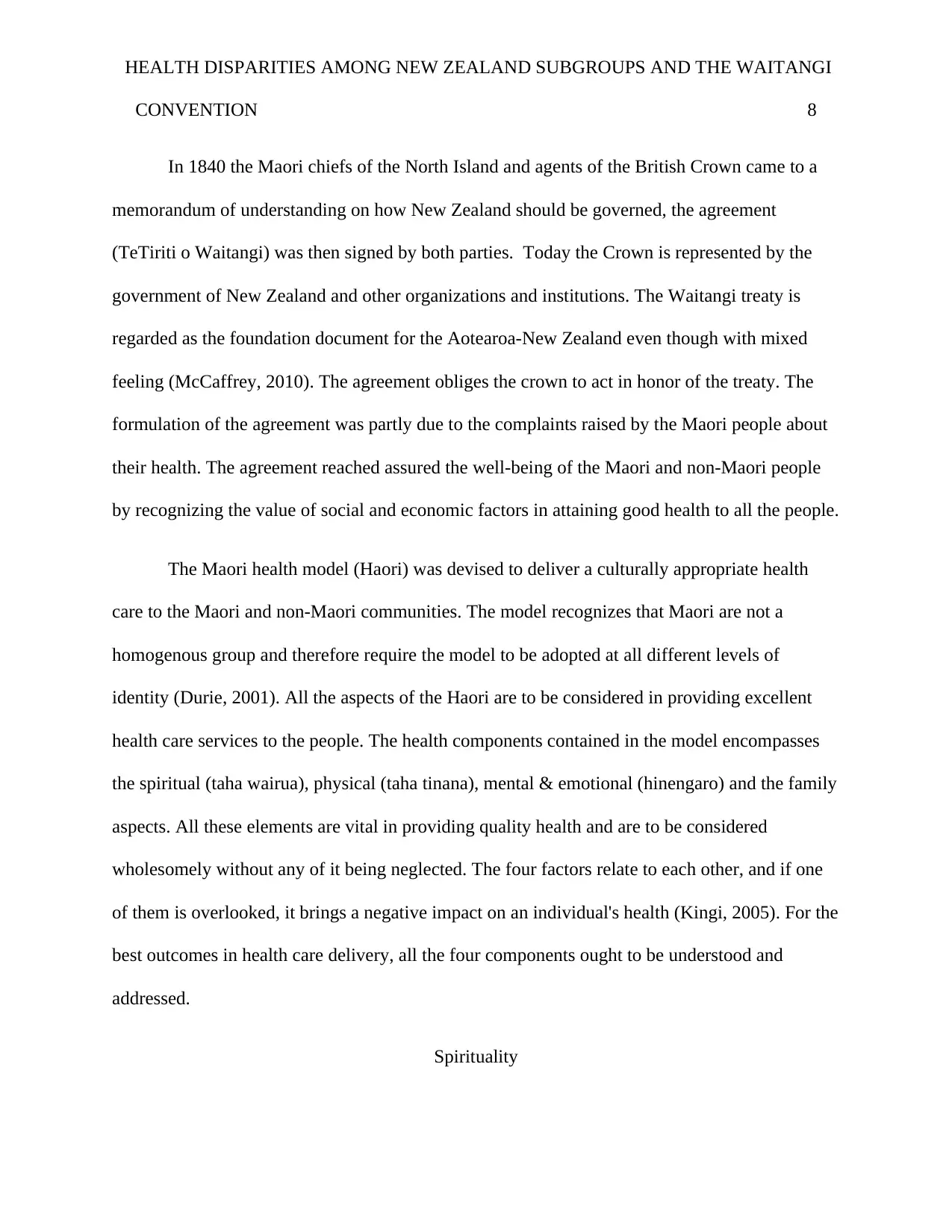
HEALTH DISPARITIES AMONG NEW ZEALAND SUBGROUPS AND THE WAITANGI
CONVENTION 8
In 1840 the Maori chiefs of the North Island and agents of the British Crown came to a
memorandum of understanding on how New Zealand should be governed, the agreement
(TeTiriti o Waitangi) was then signed by both parties. Today the Crown is represented by the
government of New Zealand and other organizations and institutions. The Waitangi treaty is
regarded as the foundation document for the Aotearoa-New Zealand even though with mixed
feeling (McCaffrey, 2010). The agreement obliges the crown to act in honor of the treaty. The
formulation of the agreement was partly due to the complaints raised by the Maori people about
their health. The agreement reached assured the well-being of the Maori and non-Maori people
by recognizing the value of social and economic factors in attaining good health to all the people.
The Maori health model (Haori) was devised to deliver a culturally appropriate health
care to the Maori and non-Maori communities. The model recognizes that Maori are not a
homogenous group and therefore require the model to be adopted at all different levels of
identity (Durie, 2001). All the aspects of the Haori are to be considered in providing excellent
health care services to the people. The health components contained in the model encompasses
the spiritual (taha wairua), physical (taha tinana), mental & emotional (hinengaro) and the family
aspects. All these elements are vital in providing quality health and are to be considered
wholesomely without any of it being neglected. The four factors relate to each other, and if one
of them is overlooked, it brings a negative impact on an individual's health (Kingi, 2005). For the
best outcomes in health care delivery, all the four components ought to be understood and
addressed.
Spirituality
CONVENTION 8
In 1840 the Maori chiefs of the North Island and agents of the British Crown came to a
memorandum of understanding on how New Zealand should be governed, the agreement
(TeTiriti o Waitangi) was then signed by both parties. Today the Crown is represented by the
government of New Zealand and other organizations and institutions. The Waitangi treaty is
regarded as the foundation document for the Aotearoa-New Zealand even though with mixed
feeling (McCaffrey, 2010). The agreement obliges the crown to act in honor of the treaty. The
formulation of the agreement was partly due to the complaints raised by the Maori people about
their health. The agreement reached assured the well-being of the Maori and non-Maori people
by recognizing the value of social and economic factors in attaining good health to all the people.
The Maori health model (Haori) was devised to deliver a culturally appropriate health
care to the Maori and non-Maori communities. The model recognizes that Maori are not a
homogenous group and therefore require the model to be adopted at all different levels of
identity (Durie, 2001). All the aspects of the Haori are to be considered in providing excellent
health care services to the people. The health components contained in the model encompasses
the spiritual (taha wairua), physical (taha tinana), mental & emotional (hinengaro) and the family
aspects. All these elements are vital in providing quality health and are to be considered
wholesomely without any of it being neglected. The four factors relate to each other, and if one
of them is overlooked, it brings a negative impact on an individual's health (Kingi, 2005). For the
best outcomes in health care delivery, all the four components ought to be understood and
addressed.
Spirituality
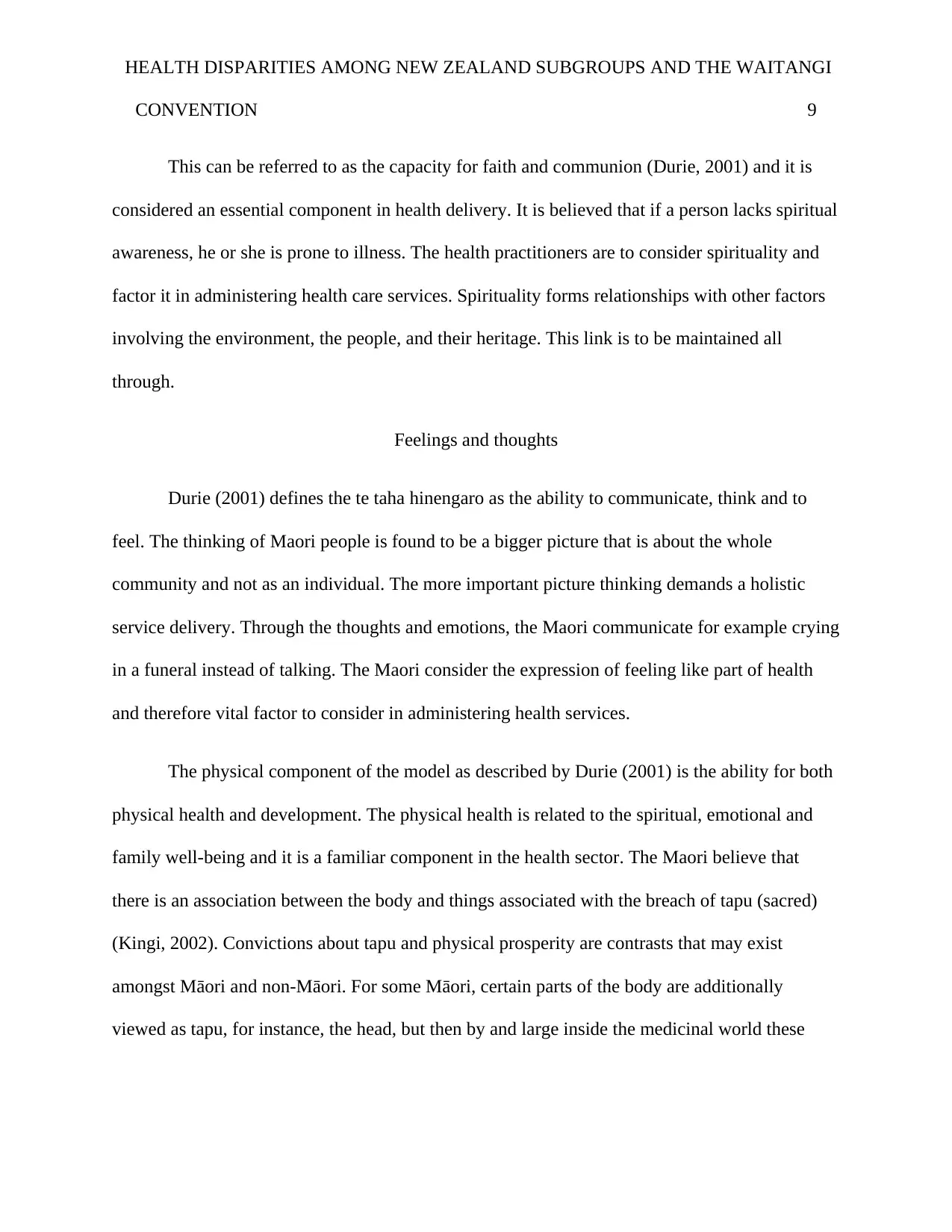
HEALTH DISPARITIES AMONG NEW ZEALAND SUBGROUPS AND THE WAITANGI
CONVENTION 9
This can be referred to as the capacity for faith and communion (Durie, 2001) and it is
considered an essential component in health delivery. It is believed that if a person lacks spiritual
awareness, he or she is prone to illness. The health practitioners are to consider spirituality and
factor it in administering health care services. Spirituality forms relationships with other factors
involving the environment, the people, and their heritage. This link is to be maintained all
through.
Feelings and thoughts
Durie (2001) defines the te taha hinengaro as the ability to communicate, think and to
feel. The thinking of Maori people is found to be a bigger picture that is about the whole
community and not as an individual. The more important picture thinking demands a holistic
service delivery. Through the thoughts and emotions, the Maori communicate for example crying
in a funeral instead of talking. The Maori consider the expression of feeling like part of health
and therefore vital factor to consider in administering health services.
The physical component of the model as described by Durie (2001) is the ability for both
physical health and development. The physical health is related to the spiritual, emotional and
family well-being and it is a familiar component in the health sector. The Maori believe that
there is an association between the body and things associated with the breach of tapu (sacred)
(Kingi, 2002). Convictions about tapu and physical prosperity are contrasts that may exist
amongst Māori and non-Māori. For some Māori, certain parts of the body are additionally
viewed as tapu, for instance, the head, but then by and large inside the medicinal world these
CONVENTION 9
This can be referred to as the capacity for faith and communion (Durie, 2001) and it is
considered an essential component in health delivery. It is believed that if a person lacks spiritual
awareness, he or she is prone to illness. The health practitioners are to consider spirituality and
factor it in administering health care services. Spirituality forms relationships with other factors
involving the environment, the people, and their heritage. This link is to be maintained all
through.
Feelings and thoughts
Durie (2001) defines the te taha hinengaro as the ability to communicate, think and to
feel. The thinking of Maori people is found to be a bigger picture that is about the whole
community and not as an individual. The more important picture thinking demands a holistic
service delivery. Through the thoughts and emotions, the Maori communicate for example crying
in a funeral instead of talking. The Maori consider the expression of feeling like part of health
and therefore vital factor to consider in administering health services.
The physical component of the model as described by Durie (2001) is the ability for both
physical health and development. The physical health is related to the spiritual, emotional and
family well-being and it is a familiar component in the health sector. The Maori believe that
there is an association between the body and things associated with the breach of tapu (sacred)
(Kingi, 2002). Convictions about tapu and physical prosperity are contrasts that may exist
amongst Māori and non-Māori. For some Māori, certain parts of the body are additionally
viewed as tapu, for instance, the head, but then by and large inside the medicinal world these
⊘ This is a preview!⊘
Do you want full access?
Subscribe today to unlock all pages.

Trusted by 1+ million students worldwide
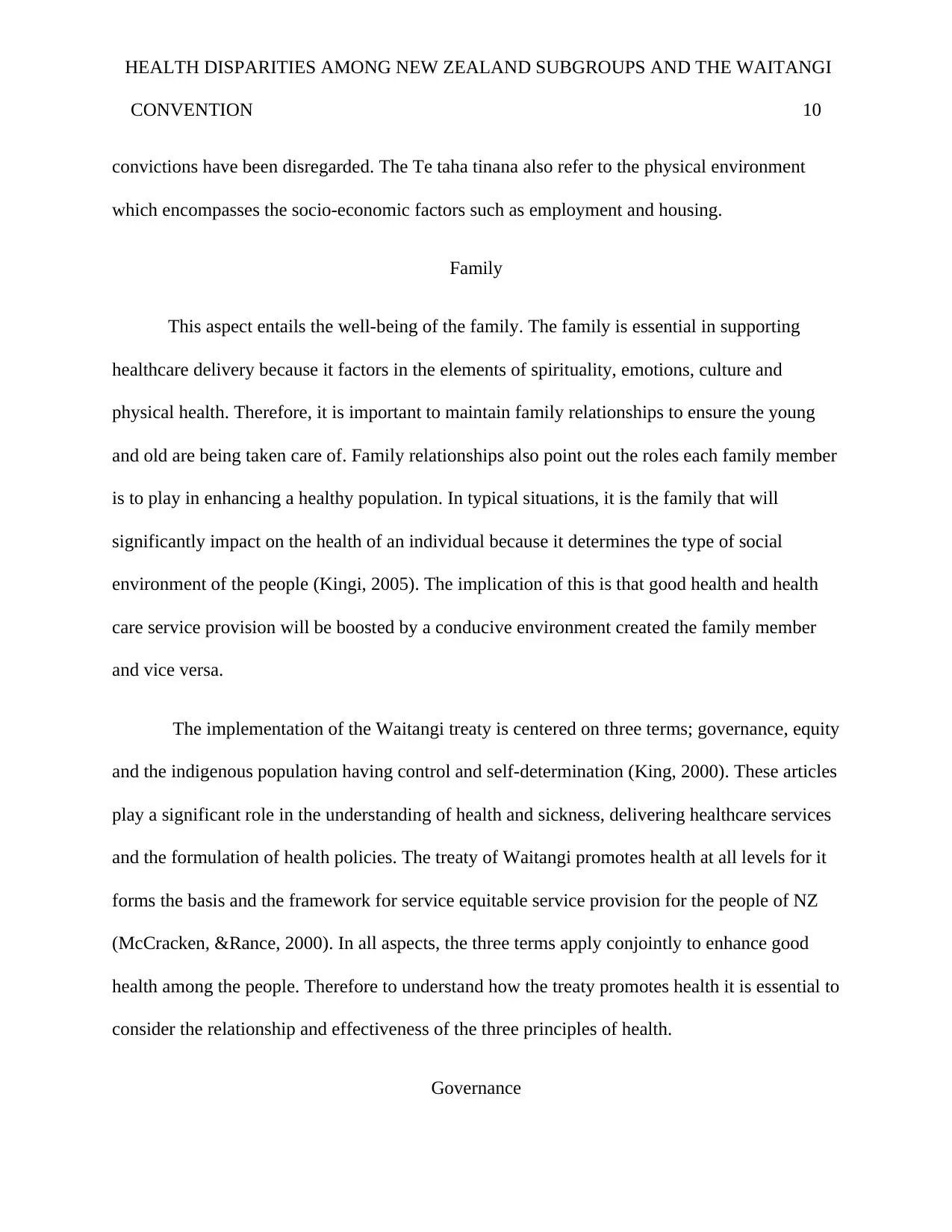
HEALTH DISPARITIES AMONG NEW ZEALAND SUBGROUPS AND THE WAITANGI
CONVENTION 10
convictions have been disregarded. The Te taha tinana also refer to the physical environment
which encompasses the socio-economic factors such as employment and housing.
Family
This aspect entails the well-being of the family. The family is essential in supporting
healthcare delivery because it factors in the elements of spirituality, emotions, culture and
physical health. Therefore, it is important to maintain family relationships to ensure the young
and old are being taken care of. Family relationships also point out the roles each family member
is to play in enhancing a healthy population. In typical situations, it is the family that will
significantly impact on the health of an individual because it determines the type of social
environment of the people (Kingi, 2005). The implication of this is that good health and health
care service provision will be boosted by a conducive environment created the family member
and vice versa.
The implementation of the Waitangi treaty is centered on three terms; governance, equity
and the indigenous population having control and self-determination (King, 2000). These articles
play a significant role in the understanding of health and sickness, delivering healthcare services
and the formulation of health policies. The treaty of Waitangi promotes health at all levels for it
forms the basis and the framework for service equitable service provision for the people of NZ
(McCracken, &Rance, 2000). In all aspects, the three terms apply conjointly to enhance good
health among the people. Therefore to understand how the treaty promotes health it is essential to
consider the relationship and effectiveness of the three principles of health.
Governance
CONVENTION 10
convictions have been disregarded. The Te taha tinana also refer to the physical environment
which encompasses the socio-economic factors such as employment and housing.
Family
This aspect entails the well-being of the family. The family is essential in supporting
healthcare delivery because it factors in the elements of spirituality, emotions, culture and
physical health. Therefore, it is important to maintain family relationships to ensure the young
and old are being taken care of. Family relationships also point out the roles each family member
is to play in enhancing a healthy population. In typical situations, it is the family that will
significantly impact on the health of an individual because it determines the type of social
environment of the people (Kingi, 2005). The implication of this is that good health and health
care service provision will be boosted by a conducive environment created the family member
and vice versa.
The implementation of the Waitangi treaty is centered on three terms; governance, equity
and the indigenous population having control and self-determination (King, 2000). These articles
play a significant role in the understanding of health and sickness, delivering healthcare services
and the formulation of health policies. The treaty of Waitangi promotes health at all levels for it
forms the basis and the framework for service equitable service provision for the people of NZ
(McCracken, &Rance, 2000). In all aspects, the three terms apply conjointly to enhance good
health among the people. Therefore to understand how the treaty promotes health it is essential to
consider the relationship and effectiveness of the three principles of health.
Governance
Paraphrase This Document
Need a fresh take? Get an instant paraphrase of this document with our AI Paraphraser
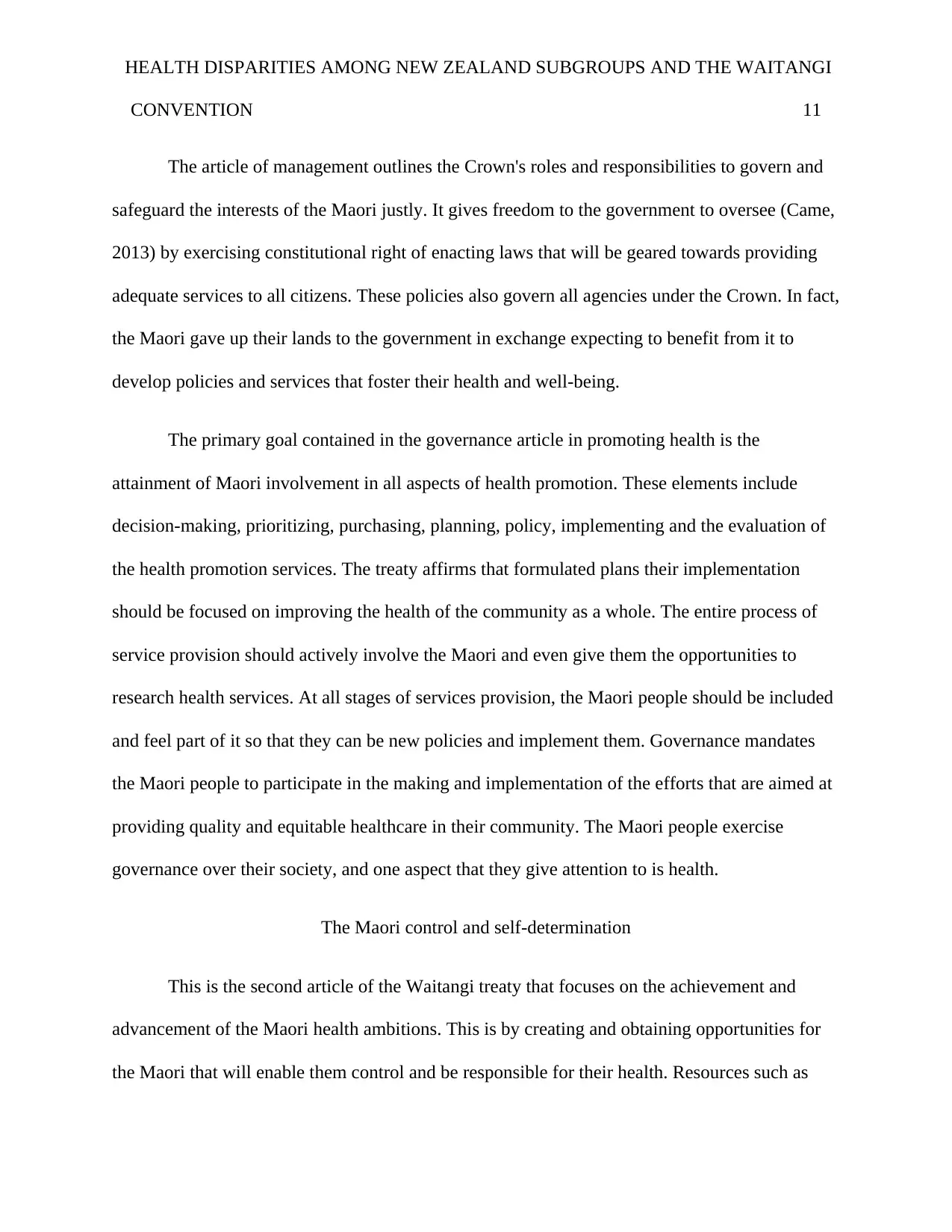
HEALTH DISPARITIES AMONG NEW ZEALAND SUBGROUPS AND THE WAITANGI
CONVENTION 11
The article of management outlines the Crown's roles and responsibilities to govern and
safeguard the interests of the Maori justly. It gives freedom to the government to oversee (Came,
2013) by exercising constitutional right of enacting laws that will be geared towards providing
adequate services to all citizens. These policies also govern all agencies under the Crown. In fact,
the Maori gave up their lands to the government in exchange expecting to benefit from it to
develop policies and services that foster their health and well-being.
The primary goal contained in the governance article in promoting health is the
attainment of Maori involvement in all aspects of health promotion. These elements include
decision-making, prioritizing, purchasing, planning, policy, implementing and the evaluation of
the health promotion services. The treaty affirms that formulated plans their implementation
should be focused on improving the health of the community as a whole. The entire process of
service provision should actively involve the Maori and even give them the opportunities to
research health services. At all stages of services provision, the Maori people should be included
and feel part of it so that they can be new policies and implement them. Governance mandates
the Maori people to participate in the making and implementation of the efforts that are aimed at
providing quality and equitable healthcare in their community. The Maori people exercise
governance over their society, and one aspect that they give attention to is health.
The Maori control and self-determination
This is the second article of the Waitangi treaty that focuses on the achievement and
advancement of the Maori health ambitions. This is by creating and obtaining opportunities for
the Maori that will enable them control and be responsible for their health. Resources such as
CONVENTION 11
The article of management outlines the Crown's roles and responsibilities to govern and
safeguard the interests of the Maori justly. It gives freedom to the government to oversee (Came,
2013) by exercising constitutional right of enacting laws that will be geared towards providing
adequate services to all citizens. These policies also govern all agencies under the Crown. In fact,
the Maori gave up their lands to the government in exchange expecting to benefit from it to
develop policies and services that foster their health and well-being.
The primary goal contained in the governance article in promoting health is the
attainment of Maori involvement in all aspects of health promotion. These elements include
decision-making, prioritizing, purchasing, planning, policy, implementing and the evaluation of
the health promotion services. The treaty affirms that formulated plans their implementation
should be focused on improving the health of the community as a whole. The entire process of
service provision should actively involve the Maori and even give them the opportunities to
research health services. At all stages of services provision, the Maori people should be included
and feel part of it so that they can be new policies and implement them. Governance mandates
the Maori people to participate in the making and implementation of the efforts that are aimed at
providing quality and equitable healthcare in their community. The Maori people exercise
governance over their society, and one aspect that they give attention to is health.
The Maori control and self-determination
This is the second article of the Waitangi treaty that focuses on the achievement and
advancement of the Maori health ambitions. This is by creating and obtaining opportunities for
the Maori that will enable them control and be responsible for their health. Resources such as
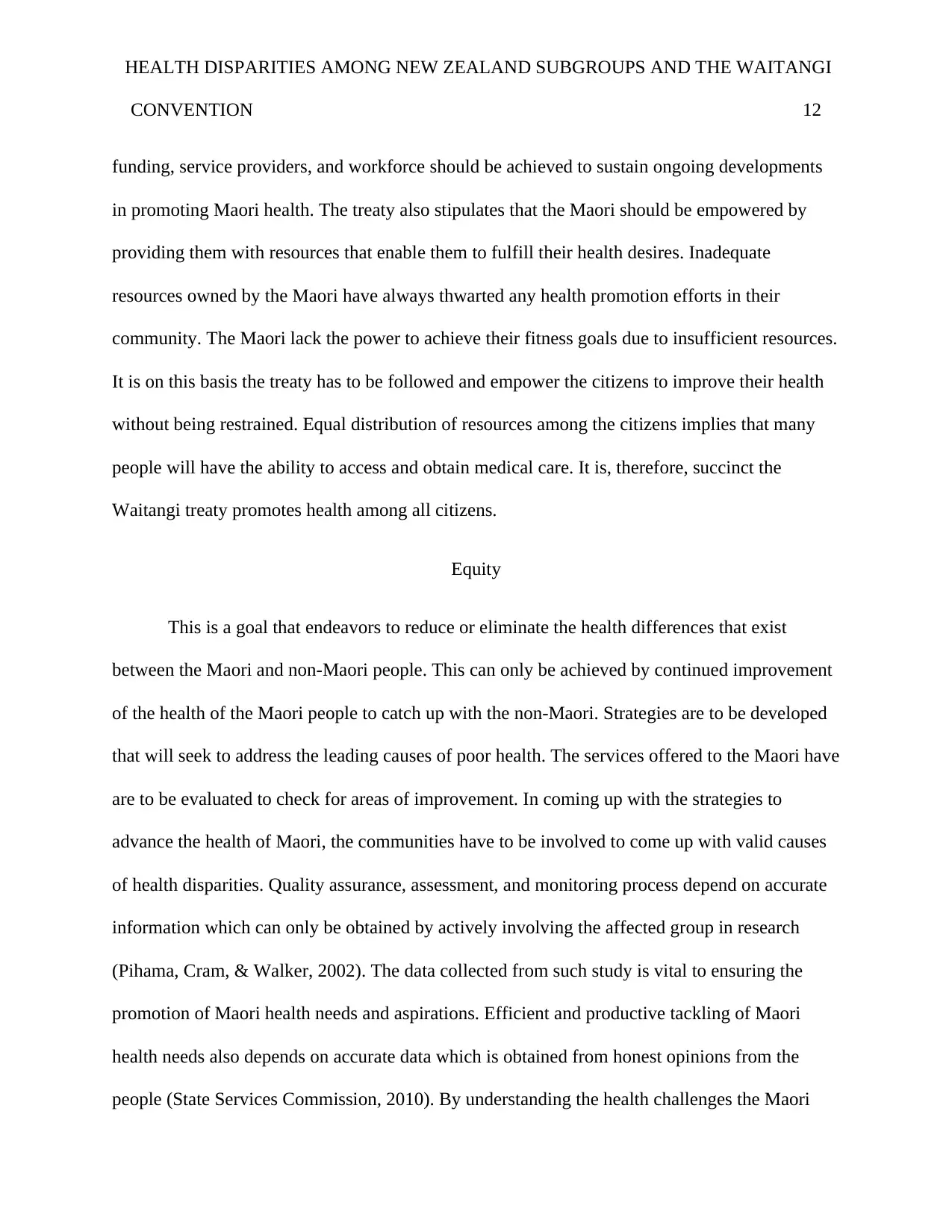
HEALTH DISPARITIES AMONG NEW ZEALAND SUBGROUPS AND THE WAITANGI
CONVENTION 12
funding, service providers, and workforce should be achieved to sustain ongoing developments
in promoting Maori health. The treaty also stipulates that the Maori should be empowered by
providing them with resources that enable them to fulfill their health desires. Inadequate
resources owned by the Maori have always thwarted any health promotion efforts in their
community. The Maori lack the power to achieve their fitness goals due to insufficient resources.
It is on this basis the treaty has to be followed and empower the citizens to improve their health
without being restrained. Equal distribution of resources among the citizens implies that many
people will have the ability to access and obtain medical care. It is, therefore, succinct the
Waitangi treaty promotes health among all citizens.
Equity
This is a goal that endeavors to reduce or eliminate the health differences that exist
between the Maori and non-Maori people. This can only be achieved by continued improvement
of the health of the Maori people to catch up with the non-Maori. Strategies are to be developed
that will seek to address the leading causes of poor health. The services offered to the Maori have
are to be evaluated to check for areas of improvement. In coming up with the strategies to
advance the health of Maori, the communities have to be involved to come up with valid causes
of health disparities. Quality assurance, assessment, and monitoring process depend on accurate
information which can only be obtained by actively involving the affected group in research
(Pihama, Cram, & Walker, 2002). The data collected from such study is vital to ensuring the
promotion of Maori health needs and aspirations. Efficient and productive tackling of Maori
health needs also depends on accurate data which is obtained from honest opinions from the
people (State Services Commission, 2010). By understanding the health challenges the Maori
CONVENTION 12
funding, service providers, and workforce should be achieved to sustain ongoing developments
in promoting Maori health. The treaty also stipulates that the Maori should be empowered by
providing them with resources that enable them to fulfill their health desires. Inadequate
resources owned by the Maori have always thwarted any health promotion efforts in their
community. The Maori lack the power to achieve their fitness goals due to insufficient resources.
It is on this basis the treaty has to be followed and empower the citizens to improve their health
without being restrained. Equal distribution of resources among the citizens implies that many
people will have the ability to access and obtain medical care. It is, therefore, succinct the
Waitangi treaty promotes health among all citizens.
Equity
This is a goal that endeavors to reduce or eliminate the health differences that exist
between the Maori and non-Maori people. This can only be achieved by continued improvement
of the health of the Maori people to catch up with the non-Maori. Strategies are to be developed
that will seek to address the leading causes of poor health. The services offered to the Maori have
are to be evaluated to check for areas of improvement. In coming up with the strategies to
advance the health of Maori, the communities have to be involved to come up with valid causes
of health disparities. Quality assurance, assessment, and monitoring process depend on accurate
information which can only be obtained by actively involving the affected group in research
(Pihama, Cram, & Walker, 2002). The data collected from such study is vital to ensuring the
promotion of Maori health needs and aspirations. Efficient and productive tackling of Maori
health needs also depends on accurate data which is obtained from honest opinions from the
people (State Services Commission, 2010). By understanding the health challenges the Maori
⊘ This is a preview!⊘
Do you want full access?
Subscribe today to unlock all pages.

Trusted by 1+ million students worldwide
1 out of 20
Related Documents
Your All-in-One AI-Powered Toolkit for Academic Success.
+13062052269
info@desklib.com
Available 24*7 on WhatsApp / Email
![[object Object]](/_next/static/media/star-bottom.7253800d.svg)
Unlock your academic potential
Copyright © 2020–2025 A2Z Services. All Rights Reserved. Developed and managed by ZUCOL.





